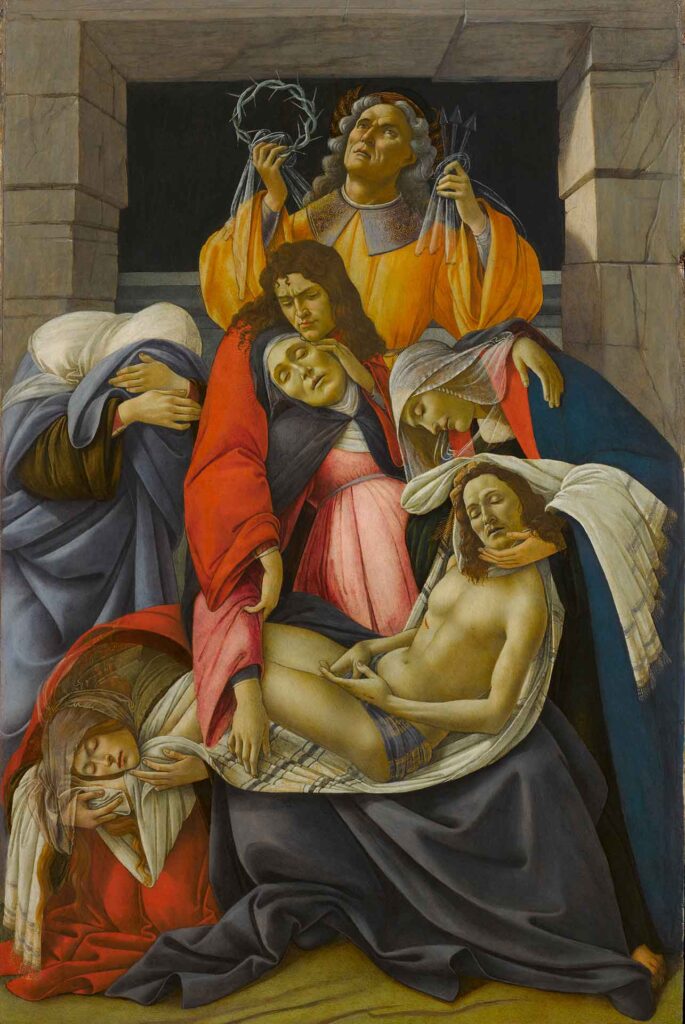The Dead Christ Mourned
Sandro Botticelli , 1495 - 1500
Description

The body of Christ lies on the knees of the fainted Madonna, who is supported by St. John the Evangelist. Mary Magdalene embraces Jesus’ feet, one of the pious women supports his head, while the other, in despair, hides her face in her mantle.
In the background, against the rock-cut tomb, stands Joseph of Arimathea who holds the crown of thorns and the nails of the cross. The figures huddling around Christ form a compact group; their eyes are closed, or covered by their hands, because they are unable to sustain the sight of that lifeless body.
The strained expression and gestures, as well as the contrast of only primary colors (blue, red and yellow) accentuate the intense pathos of the scene, in which Botticelli has abandoned the grace and serenity of his early works.
The panel, datable between 1495 and 1500 shows the stylistic change that, since the early 1490s, Botticelli’s painting underwent in relation to the new, intense religious sentiment aroused in him by the severe preaching of the Dominican friar Gerolamo Savonarola, which invested the entire city of Florence. Savonarola’s call to a more ascetic religiosity, together with the disorientation caused by the death of Lorenzo de’ Medici, ruler of Florence and great patron of the arts, in 1492, generated in the artist a state of great spiritual anxiety.
Poldi Pezzoli’s The Dead Christ Mourned has been identified with the altarpiece of a small funerary altar set against a pillar of the Florentine church of Santa Maria Maggiore, still there in mid-16th century. Documentary traces of the panel were lost in in the 18th century. Gian Giacomo Poldi Pezzoli purchased it on March 12, 1879, only a month and a half before his death.
Data Sheet
Author
Sandro Botticelli, 1445-1510
Date
1495 - 1500
Material and technique
Tempera on panel
Measures
106 cm x 71 cm
Acquisition
Gian Giacomo Poldi Pezzoli bequest, 1879
Inventory number
1558
location
Golden Room
The Golden Room is the most important room in the Museum and houses the masterpieces of painting from the Poldi Pezzoli collection. Conceived according to the dictates of the Renaissance style, it was designed to be the hall of honor of Gian Giacomo’s apartment. After the collector’s death, Giuseppe Bertini carried on the work: unfortunately, both the gilded coffered ceiling, the frescoes, painted by Bertini himself, and the damask fabric decorations that lined the walls were destroyed by bombing. The current museographic arrangement dates back to the 1990s. Among the works on display are the Portrait of a Lady attributed to Piero del Pollaiolo and which has become a symbol of the museum, Bellini’s Imago Pietatis, Botticelli’s Lamentation over the Dead Christ, Mantegna’s Madonna and Child, and Piero della Francesca’s Saint Nicholas of Tolentino. The display case separating the Salone Dorato from the Sala degli Stucchi houses the porcelain and majolica collections.
collection
Paintings
The Museum hosts over 300 paintings. Among them, many Italian works from the Renaissance: masterpieces from Tuscany (Botticelli, Piero della Francesca, Pollaiuolo), Lombardy (Luini, Boltraffio, Solario) and Veneto (Bellini, Mantegna). Important is also the group of 18th century Italian painting (Guardi, Canaletto, Tiepolo, Fra Galgario). In the collection, there are mainly portraits and small size paintings.
